(This article was first emailed on May 31st, 2021 to fans who had registered an interest in finding out more about our Tricorder.)
Once upon a time, behind the tricorder’s upper door, to the left of the moiré disc, there was a row of eight curved aluminium features. Although their purpose was never made clear on screen, some tidbits of hearsay, extrapolation from scenes where Mr. Spock comes tantalisingly close to revealing their purpose, and an interpretation of that famous Wah Chang tricorder sketch, has led many fans, us amongst them, to conclude that these features were intended to be removable information or function-boosting discs.
Working on creating a replica of a 50-year-old science fiction prop is a bit like peering into the workings of a vintage time machine: the more you look, the more you learn about the past and how we see the future.
Since the invention of the gramophone in the 1880s, for more than a century, discs of one form or another were the predominant format for machine-readable information storage. As Star Trek was being brought to life, International Business Machines Corporation (IBM) was in the process of introducing read-write memory drives in the form of removable magnetic media discs. Eight discs high and 360 mm (14”) in diameter, and costing a cool quarter of a million dollars, the then-revolutionary IBM 2314 was able to store 233 MB of information. It is not unreasonable to conclude that Chang knew of IBM’s hi-tech data storage solution, and imagined a future where those monster discs would be reduced to thumb-sized drives that could quickly be swapped in and out of a handheld computer in order to augment its capability.
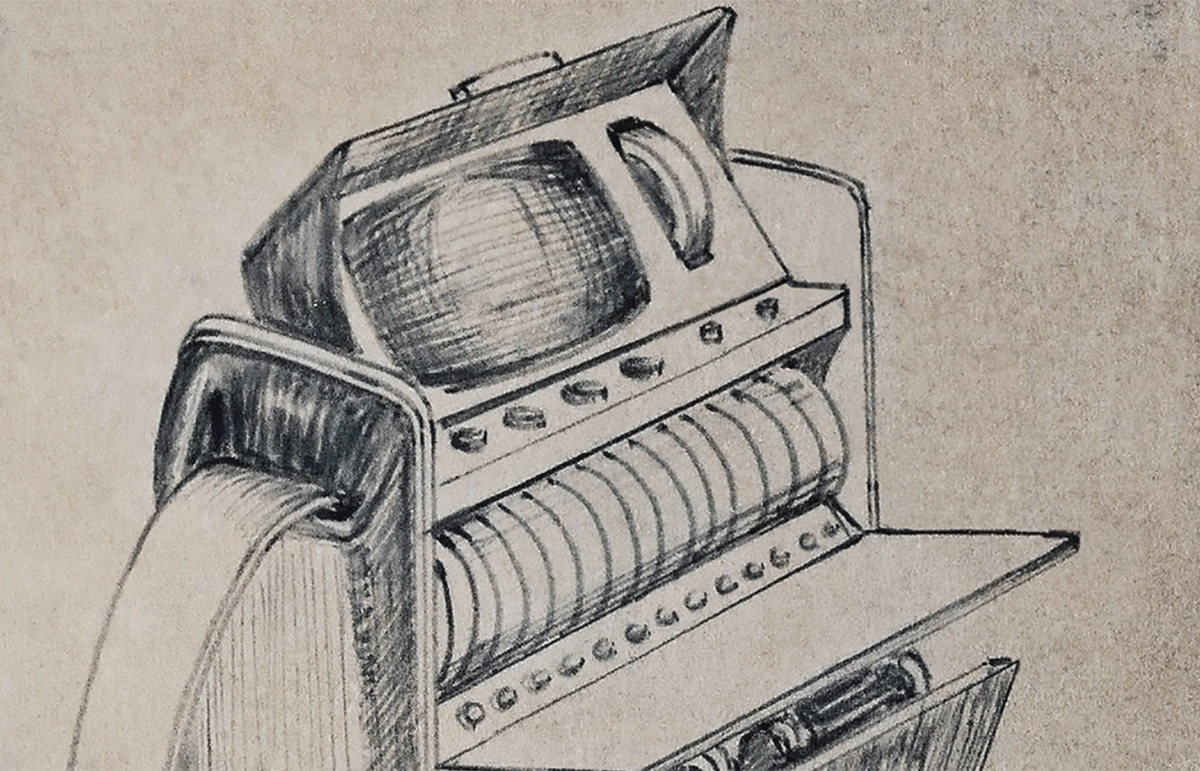
Wah Chang’s original design shows what look like miniature computer discs and a disc drive slot.
Right from our earliest tricorder development discussions, we felt it was our duty to do something special with the removable data disc concept, which we knew would add a level of immersive interaction and realism to our replica tricorder. Initial thoughts of creating plug-in data discs with USB flash drives buried in them were quickly ruled out. Not only are the discs very close together – requiring a push-to-release mechanism to access them – but we felt that a prosaic, and obviously 20th century, USB plug would look clumsily incongruous on a piece of 23rd century tech, especially when compared with the other uncluttered-looking memory cards clearly in use on the Enterprise.
Our first task was to design an ejector mechanism that would work smoothly and reliably, and fit in the limited space the prop has to offer in this area. The eight-disc array is fairly tightly boxed in between the hood, the lower compartment cavity wall and the back of the tricorder. Disc insertion and ejection is further complicated by the fact that the disc diameter is larger than the apparent opening the discs must pass through to be taken in and out of their dock. An array of spring-loaded latching switches attached to thin, crescent-shaped, bendy ‘catcher’s mitts’, which flex to hold and eject the discs, coupled with an upper “glamour bar” that rotates out of the way when a disc is ejected, provided the aesthetic functionality we were after. With all the discs inserted, and while being displayed in a cabinet, the glamour bar springs into position over the top of the array and the tricorder looks perfectly like a pristine version of the first season hero. But for those that want to boldly go beyond display and into the realm of realistic function, pressing any one of the discs ejects it with a satisfyingly premium click. The latching switch at the back of each disc slot tells the tricorder’s software which of the slots have discs in them.
With the ejector’s mechanical design well on the way to completion, we went to work on making the discs a plausibly functional part of the tricorder’s operation. Initially, we considered ways of ‘writing’ even just small amounts of data wirelessly to the discs (using an RFID chip embedded in the disc), but technical issues caused by the proximity of discs to each other, and the metal outer ring, closed down that idea. Given the capability of the tricorder’s internal electronics, and the onboard memory’s ability to cope with the functions we had planned for it, our thinking moved away from the complexity of adding hardware to each disc. To make the discs integral to the tricorder’s operation, for example, using them to activate the tricorder’s various functions, the tricorder has to be able to identify each disc. To simplify the identification process and add another level to the interaction required by the user to operate the tricorder, we chose to only monitor the disc slot furthest to the right. Using this as the activation position ties nicely in with the possibility that, in the hero prop’s original incarnation, this particular disc was the removable one. The right-most slot also allows us to hide the disc identification sensor behind the moiré panel.
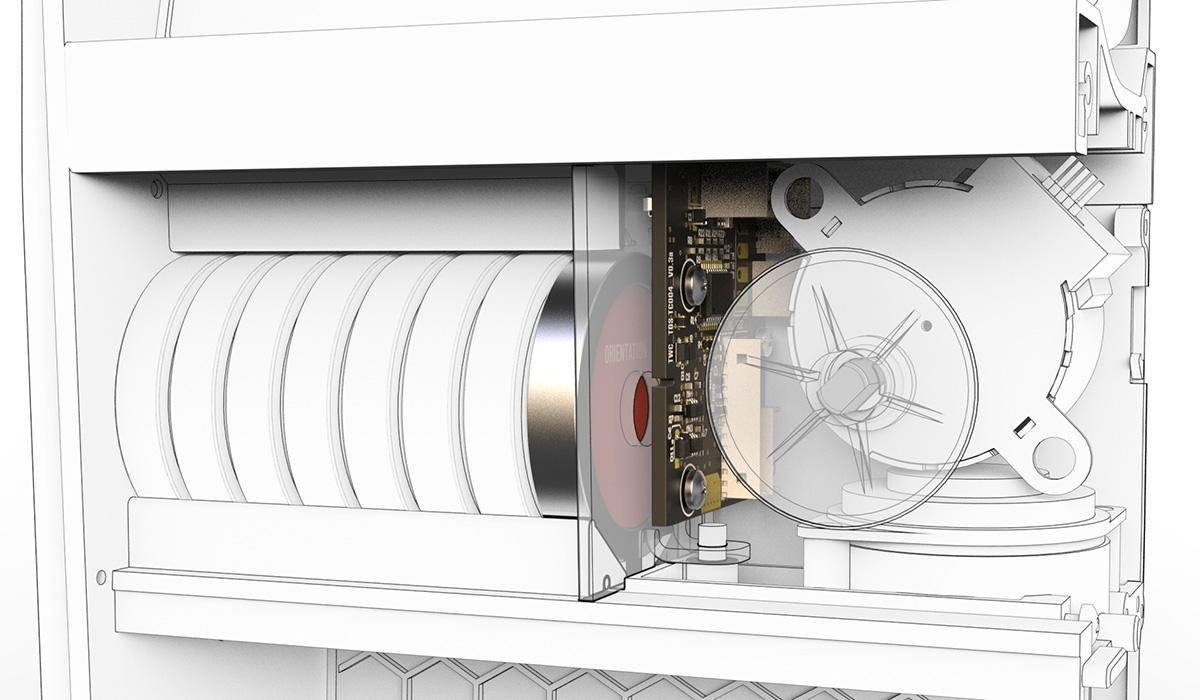
On the back of the mid PCB the disc colour sensor shines RGB light onto the disc and measures the amount of each reflected back to identify which disc has been inserted.
To identify the discs, we chose colour sensing: it is human-readable, robust and reliable, and yet being non-obvious to the untrained user, appears suitably sci-fi. To add the necessary colour to the otherwise metal discs, in the absence of any hard evidence, once again Wah Chang’s sketch points the way. In it, what looks like a disc can be seen protruding from a socket next to the display. Although this particular feature never made it into the final design, the image shows what looks like a disc with a rim wrapped around a contrasting material. For the actual colours, The Original Series has a large and vibrant colour palette and there are plenty of richly coloured memory blocks and console switches which, between them, offer more than enough colours to provide an in-universe range of coloured disc inserts that an optical sensor can reliably differentiate between.
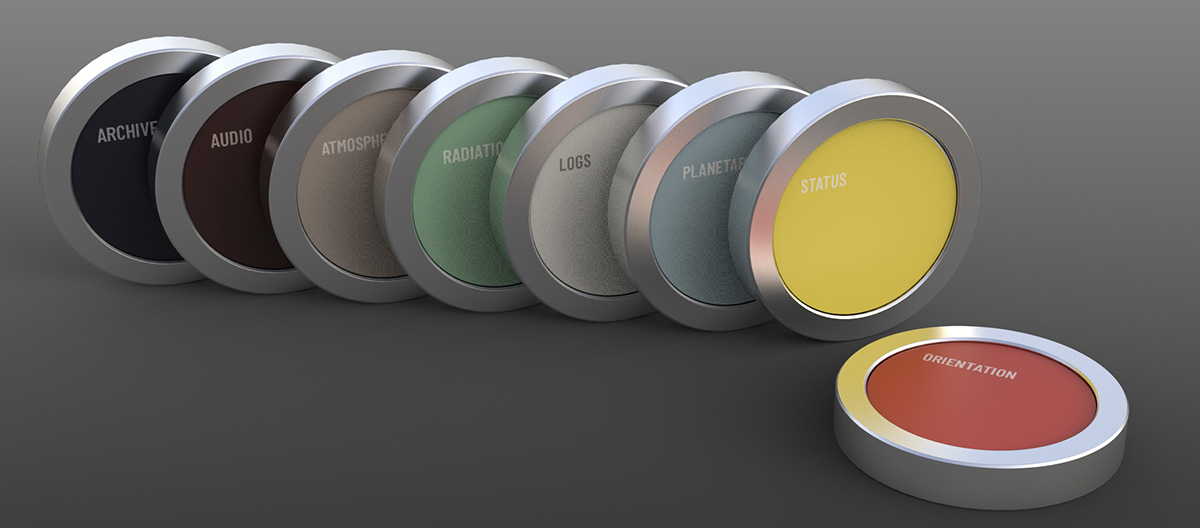
After some discussion and valuable fan input, the disc colours mostly match the helm switch bank.
In use, inserting any of the discs into the right-most slot enables the user to access that particular disc’s set of related functions, information or files, and calls up any previously recorded data for those sensor functions. By using them in this way to control the tricorder, the discs become a properly engaging and integral part of the user interface, each one effectively acting as a specific data access key. The sensors, such as humidity, temperature and pressure, are interrelated so instead of assigning the function of a single sensor to each disc (and then leaving the other exciting tricorder functions buried in somewhere else in the user interface), we grouped the tricorder’s mix of dynamic and static information, capabilities and functions together more intuitively by usage.

Discs group the tricorder’s mix of dynamic and static information, capabilities and functions.

Different options for human-readable data disc identification were considered.
Our tricorder does more than just sense and record data from the environment. Its capabilities will be explored in detail in future posts, but in broad terms, as a replica of a portable computer, it also has data banks that contain a catalogue of Captain’s Logs entries; access to the “status” of the Enterprise; information relating to its own internal status; statistics and useful data about the planets in our home solar system; and a small collection of historical archive files.
The tricorder is not just a replica of a measuring and recording device: it is a realistic incarnation of one of science fiction’s most heroic props and perhaps the earliest vision of a mobile computing future that we all now take for granted. At its heart, our tricorder replica isn’t a scientific instrument – in the round, it’s the embodiment of a shared dream that every Star Trek fan holds dear.
LLAP
Chris

Coming next time
Moiré – The fringes of science
Fans who register with us will be the first to read our news and the progress of this exciting Tricorder development and, later, where and when to purchase it. You can catch up with the story so far here on this blog, but if you haven’t already done so, why not register your interest in the Tricorder – you’ll then receive a personalised registration certificate and early access to these updates (before we publish them on our website).


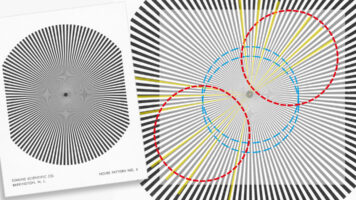
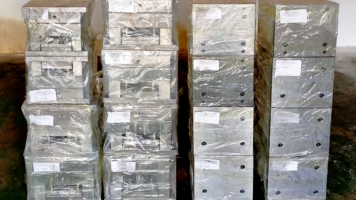
Are there any new availability estimates?
Can’t rush magic.
Can’t wait , roughly when will it be out ?
What a fantastic and u formative update that excites me even more and primes me for the eventual purchase.
I am already registered and have a certificate!
I think the speculative color palette for the discs is perfect.
Appreciate that the Wand team was open to those suggestions.
And I’m excited to feel the weight of the individual discs.
Can you offer any details on their construction?
For example, what is the material used for the outer rim?
About how much do they weigh?
Etc.
Thanks for your kind words, I’m glad you like the colour palette. I am not sure of the exact weight of the disc, because we don’t have the finished injection moulded disc yet. However, I can tell you that we are optimising it for weight and feel. The outer rim of the disc is aluminium, the colour panels on either side are injection-moulded ABS and then there is a steel washer trapped in the middle to give extra mass. Obviously, given the size of it, there is a limit to how heavy it can be, or indeed should be. As soon as we get our first shots I will weigh one and we can see exactly how much it weighs.
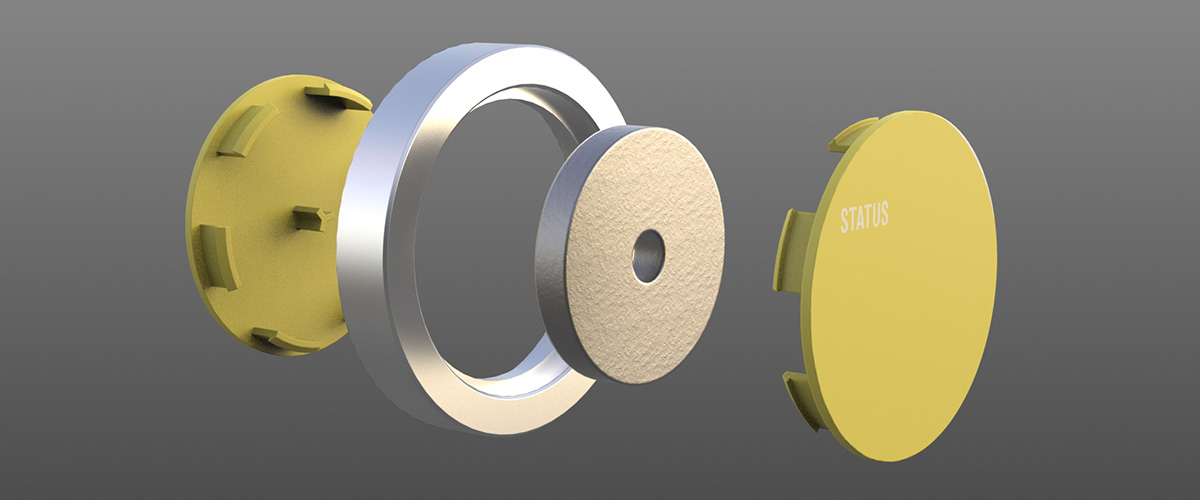
Chris, I like the self locating feature of the colour panels. I was concerned that dusting mass production the panels could be difficult to get centered and each disk would be slightly different. Great attention to repeatable producibility.
GREAT update! And the functions you’ve built-in to this tiny space is just amazing. Congratulations!
Two things mentioned here intrigue me.
First, you state “inserting any of the discs into the right-most slot enables the user to access that particular disc’s set of related functions, information or files, and calls up any previously recorded data for those sensor functions”. This is very cool and makes perfect sense for ‘realistic’ usage. But you also state: “The latching switch at the back of each disc slot tells the tricorder’s software which of the slots have discs in them.” Since the color sensor is what gives one access to particular functions, what does the “software” you mention do when there are and are not dics in a given slot?
Second, in the past you’ve confirmed there will be no video *recording* capabilities for your Tricorder. Again, this makes perfect sense. But your function descriptions here repeatedly mention “images” and “data” only. They do not seem to reference any video *playback* capabilities whatsoever. Does your Tricorder, as designed, have any video *playback* software or abilities built into it?
Thanks for all this wonderful news and information!
This is going to be amazing! So much work has gone into the smallest of details as well as these mind-blowing discs that will work! I know what I want for Christmas, Valentine’s Day, Mother’s Day, my birthday, or Anniversary, whenever it hits the market, lol!!
Lovely update. Any chance of fresh prototype photos in the next one?
Hi Chris,
Suppose I’m in the car and my passenger wants to measure how many G’s we’re pulling in a turn before she comments on our current speed…is there a way to quickly find the ‘Orientation’ disk? Keep in mind I was probably using the ‘Atmosphere’ disk to prove that the air isn’t nearly as cold as someone else was asserting…not while driving, of course.
That makes me wonder…will there be any volume control available? It is possible, though I don’t see how, that some people around me may not be as excited to hear tricorder sounds as I am. Crazy, I know…but it’s possible.
I can not wait to hold this thing in my hands! I own the rock mood light, phaser and communicator and they are all really well done. I’m really excited to be able to complete the Landing Party set.
You have to love the fact that judging by some of the renders and pictures this is further on in its development than is being let on but the breadcrumbs keep us keen and hungry. I dont care you had my money at “we are making a tricorder”. Everything else is just topping. Complete the triumvate and let us know when we need to empty the wallets by. All joking aside this is looking like one of your best items yet and its place next to all your other star trek props is already reserved
Thanks for your support and enthusiasm. A development of this nature was always going to take longer than we thought… but we are crunching through the work and it is great to be able to share the journey with everyone.
I just want to say, this is one of the most exciting items that has ever been produced, ever! I am beside myself with the work being put into this; but more than that, the sharing of the production process and behind-the-scenes planning and engineering is something I’ve never seen from a company like this before! I truly look forward to the day I unbox this thing of beauty.
Hello Chris Barnardo –
Will your upcoming Tricorder Kydex texture be the same as that on your prior Communicator? The Trek community felt the Communicator had a rather over pronounced texture, whereas the Jein Tricorder (and other known Kydex props) have a more subtle texture and sheen.
Some of the Trek community have attempted to buff the texture down but it’s a very tricky thing to do once the Communicators were fully assembled!
Thanks for making all these wonderful Trek props for us to finally own!
The short answer is yes. The Kydex texture is not a simple acid etch. The texture has a 3D shape to it. As a result, we decided to replicate that using a laser etching process. The process is very time-consuming and expensive, on top of that it’s a one time deal… once the mould is textured it’s go with that finish, or make a new mould and then have it textured again. For the communicator’s surface texture, there was no easy way of trying it out. We had had some sample steel blocks laser-carved out at different depths using the texture pattern file, but they were negative versions of the texture. So we then poured casting rubber onto the blocks so that we could try and gauge the best depth. Unfortunately, the casting rubber while taking a great impression, was rather matt and soft and so gave a false view of the visual depth of the texture. In the end, as a result of that, the one we chose turned out looking a little deeper than we would have wanted, once it was moulded in ABS. We are using the same process and in fact, the same company to texture the tricorder tooling and we obviously learnt a great deal from the communicator experience which we will be factoring into our decisions over the depth of the tricorder texture in order to make the tricorder texture a little shallower.
Thanks so much for your very thoughtful and detailed answer on this detail. Hopefully the pattern will be optimized with the experience from the last run.
The work you and your associates is nothing short of miraculous and we are all very appreciative of the exhaustive work you are undoubtedly putting into this endeavor! Thanks also for these regular blog updates being the creators of such an impressive series of Trek products!
This is just totally amazing. Without a doubt, this will be the coolest, most amazing high tech Star Trek product ever made!
For the lazy of us, there should be an option to use all the functions without changing the discs.
A wonderful journey you guys are on for all of us!
I have a different interpretation of the disks though. If you watch how the Tricorder is used, in particular by Nimoy, the top tray is normally open, facing outwards. He fans his hand over the disks and it looks for all the world like he is manipulating them. This, combined with the fact that opening the top flap exposed the very exotic moiré pattern, always led me to believe that the disks were subtle controls for the scanner, and the moiré disk was either the scanner itself or a representation of the scanning field. (Look at the photos in your section on the Moiré pattern for what I’m referring to)
Of course, I don’t think there’s anyway to be certain, and Wah’s original intent may have been interpreted differently by the actors on screen, but FWIW this is how I always thought they ‘functioned’.
Naturally, we all had to overlook the obvious silly placement of the screen facing away from the actor’s when they used them, unless they were looking at the screen for information rather than scanning – but, like all prop enthusiasts, I quibble 🙂
Can’t wait to see the result of all your hard work in person. It’s amazing what you guys can do with stone knives and bear skins!
“silly placement of the screen facing away from the actor’s when they used them”
I rationalized that by adding an additional display on the bottom of the rotated top (either in the back or front) that was not visible to the audience. For more detailed visual data or sharing with other people the main screen would be used.
What to add here? I find myself thinking Humanity may be salvageable after all! Stumbled across this and am so excited it’s almost pathological for a 58-year-old. I have your previous TOS releases, and still marvel at their value, accuracy and desirability (Only tempered somewhat by fear of a battery dying in one of my Phasers, nightmare-inducing stuff indeed….) Being a machinist with a meticulous nature, these updates cause a Pavlovian response that lend greatly to the overall experience and are much appreciated, really- Thanks so much for these!
It’s harder and harder to find real quality any more, let alone a level of design that shows so much love. Your devotion to every piece of this goes well beyond the expected, and your pricing makes me feel that your products are the best money I’ve ever spent- Personally, I’d pay a lot more if you decide to throw practicality to the wind & say “Just how advanced can we possibly make this thing?!?” Kudos to your obsessive team, your work is off the scale.
Finally a full wand away set to go with my masters replicas and Roddenberry/ HMS set.
The Trifecta of 9 will be complete.
Took me time to read all the comments, but I seriously enjoyed the write-up. It proved to be Very helpful to me and I am positive to all the commenters right here. It’s always good when you can not only be informed but also entertained I’m sure you had fun writing this article.
Given this looks to have FM radio capabilities, will it have a headphone jack and/or bluetooth capabilities?
No I am afraid not, and the FM radio is not a 100% given at this point, depending on some more investigation on how we see the FM radio chip performs in the final build, we may or may not include this function
I still want one
Patiently Waiting
thank you… extreme patience is indeed needed
Hi Chris,
Please. Take your time. I’ve already registered for the preorder and I can’t wait to order one,,,,just one. But you cannot rush perfection. And this will be worth waiting for.
Thanks for creating such a massive piece of Star Trek history.
Thanks Gregg!
I was hopping that the planet disk would have other worlds on it. Like other planets of the UFP. You could make a second planet disk
As I said in answer to a previous similar request: we did think this was a good idea to start with, but we couldn’t be sure at all of getting accurate images of each planet that, a) we could license, b) that we wouldn’t have fans arguing over if we’d got it wrong or used the wrong image etc., c) we didn’t think we could get the full set if planetary stats together for each of the alien planets, thus leaving gaps in the data or leaving us the unenviable task of fabricating the information, and finally, d) we couldn’t be sure to get a list of Star Trek planets that everyone was happy with… I mean who would thank us for missing out their favourite xeno-world, so we abandoned the idea.
Note also that the discs do not contain the information, that is programmed into the tricorder, the discs are merely an in universe way of accessing the data as if it was on the discs.
Are the atmosphere sensors like barometric still included in the final release?